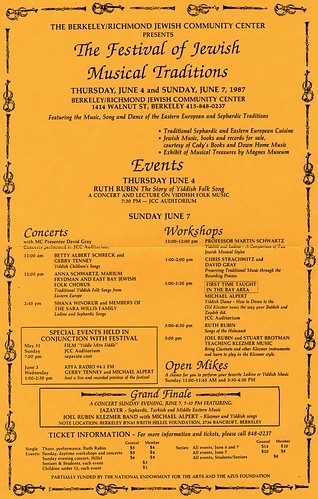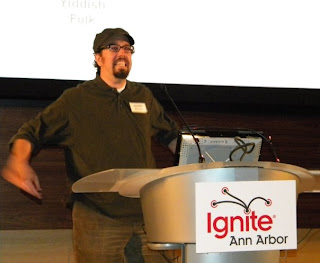
I ran across an fascinating description of
Matisyahu's new album, Light in
Chasidi News yesterday. Along with Light there were about twenty new Chassidic recordings featured, all of which were written up in the classic frum music promotion style.
As I've mentioned before, I find this writing style both fascinating and frustrating in equal measures. It's fascinating because it provides a window into what this community prioritizes. It's frustrating because, to an outsider who prioritizes different things, the writing appears opaque and uninformative.

I've got a few thoughts on this, but first here's one view of the new
Matisyahu album, Light, written by the Chasidi News. For twenty other album descriptions written in this style check the current issue of
Chasidi News or any one of the frum music blogs I list.
Light - Matisyahu’s third album is now in the stores. After working on it for two years, ‘Light’, Matisyahu’s third album is released. After the meteoric success of his two previous albums, the Chasidic singer Matisyahu releases his third album which illuminates his unique musical style. Matisyahu worked on the album with best of musicians and musical producers, and together they brew the wonderful result, Light. The tracks on the CD range between different styles and let us feel Matisyahu’s modern special character, all of them together passing on a message of hope for peace and comradeship. The album, with 13 songs plus another bonus song, is not something to be taken for granted. “The meaning of being a singer, as far as I’m concerned, is to feel how the existence of the world echoes within you, and then express it,” explains Matisyahu, “It’s a process that changes all the time”. The album’s bonus song is called, “Two Child One Drop”, taking part in it are the cantor Yehuda Solomon and the musician Shalom Mor who plays the oud and the tar. Distribution: NMC United.
Now here's a second view of Matisyahu written by
David Jeffries of the All Music Guide. The AMG, if you're not familiar with it, provides a database of music descriptions to a lot of commercial websites. I pinched this one from
Pandora, but I'm sure it's on a hundred other websites as well.
As an American Hasidic Jewish reggae superstar, Matisyahu is an obvious outsider. After a debut album that felt live plus a follow-up album that was recorded live, the singer's ambition to do more with the studio presentation of his music left any sensible packaging up to the producer. The mismatch with fellow mystic Bill Laswell caused 2006's Youth to wander and sprawl, but industry vet David Kahne handles much of Light, and the difference is huge. Kahne packaged reggae-pop acts like Sublime and Fishbone -- whose members show up here -- before, but here he's primarily focused on Matisyahu's wide view, love of ancient history, and spiritual heart. The results are comparable to So and all the Peter Gabriel albums after, with high-tech and polish helping to drive home the artist's reverence and sense of wonder. Sounding like breakthrough hit "Chop 'Em Down"'s little brother, "Smash Lies" is an effective opener plus a dancehall-driven crowd-pleaser that'll give way to an album less reggae than any previous. Besides a little "singjay" in his vocal style, the grand, key track "One Day" has little to do with Jamaican music, and the equally moving "For You" is more likely influenced by Tears for Fears than Bob Marley. Joel Madden makes crunching punk-pop guitar the centerpiece of "Darkness into Light," and ethereal closer "Silence" could be passed off as from the Dave Matthews songbook if the lines written in Hebrew didn't give Matisyahu away. Whether using his voice as a whisper or as a giant call across nations, the depth of feeling comes through brilliantly, and if the musical soundscape isn't familiar, the empowering and sincere lyrics most definitely are. Add Kahne's instantly accessible production and Light is not only a welcome surprise, but an album that matches his debut.
Yeah, we're talking about the same album here.
What the frum music press prioritizes is tradition, community, and good character. Artist bios and album descriptions provide the artists credentials as frum Jews with familiar names and famous previous albums, and/or famous current collaborators. We're told the new songs are original, awe-inspiring, instant classics. We're told the names of individual songs, many of which were not written by the singer or band and were well known prior to the album. There will be vauge comments that the artist has an individual style, but there is rarely an attempt to describe that style. The result is that you're not given anything with which to discriminate the 20 album descriptions on the page from each other. But that's the point. The descriptions are to help you descriminate these recordings from the recordings
not on the page...the million or so non-frum, non-community, non-Chassidic albums.
The fluffery used by mainstream Western popular music promotion and review writing, of which I am regularly guilty, tends to focus on and exaggerate minor stylistic differences, exaggerate artist musical prowess, and establish artificial musical lineages and comparisons. This is all in the attempt to help an audience understand how the bands or albums compare to each other and to previous albums the reader would have heard. The result is much more of a focus on the band's
sound than on their
suitability for a specific community.There is a big caveat to this, though. If you read reviews or blurbs in zines or websites that are heavily focused on a specific narrow audience, you'll see a lot more Chassidic style writing. I remember being a teen eagerly tearing through print copies of
Maximum Rock and Roll. A lot of the prose there focused on punk credentials as defined by what label the band was on and what well known punk band the members used to play in. Not much of a difference from the frum-pop writing. In both cases, the main thing was to justify membership in the community.
What's frustrating for me about the frum writing is that it's very difficult to deal with as an outsider. I'm not interested in discriminating based on community membership. I'm not part of the Chassidic community (though I happily rub shoulders with it on occasion). I'm trying to identify good music that I and my readers might be interested in. And the frum writing doesn't help at all. Which, of course, is my problem not theirs.













